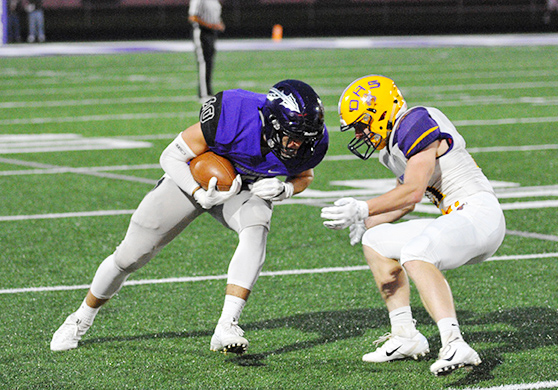Football: Pound the defensive line with this combination offense
The Pistol-Flex is a hybrid of the strengths of both the Pistol and Flexbone offenses. The Pistol-Flex T package is just one of the possible variations that this flexible offense offers.
The following are the four best plays to show just how dominant the run game is within this offensive philosophy. This run-first offense wears down the defensive front with a constant pounding.
Pistol-Flex: Open T veer right
This is the base play for the T package of running plays. The three other run plays feed off this single play. The veer play is a base triple-option play where the quarterback has three options: Dive, pitch or keep.
DIAGRAM 1: Pistol-Flex: Open T veer right. Prior to the snap, the QB must find his two reads: Dive and pitch keys. By definition, the dive key is the first defensive lineman on or outside of the play-side offensive tackle. In this case, that player is the five-tech defensive end (highlighted in the box).
Next, the QB identifies his pitch-key defender (the next defensive player outside the dive key). In this case, the pitch key is the cornerback (highlighted in the triangle).
Both the dive and pitch keys are unblocked. The QB reads these players, which gives your offense an immediate numbers advantage at the point of attack.
On the snap of the ball, the QB and B-back go into their mesh (nothing more than a soft squeeze on the ball by the B-back as the QB decides whether or not to give the ball to the diving back). The B-backs aiming point is the middle of the offensive guard.
The QB’s one-way thought process on the dive read is this: Give the ball every time to the diving B-back unless the dive key defender comes down both hard and flat on the B-back. If he does come down hard and flat, the ball is pulled by the QB and he progresses to his next assignment (attacking his pitch key).
Assuming the ball is pulled, the QB now attacks the inside thigh of his pitch key. The QB’s one-way thought process on the pitch read is this: Keep the ball every time and run off-tackle unless the pitch key defenders outside shoulder turns toward the QB and he comes down flat.
If that happens, the QB pitches the ball to his trailing A-back (who maintains a 4-yard-by-4-yard pitch relationship with the QB at all times).
Here are the other player assignments for this play:
- Z: Get to the third level.
- Play-side A-back: Arc to the second level and seal off the backside pursuit.
- Play-side tackle: Inside release and get to the second level.
- Play-side guard: Cut the defensive tackle.
- Center & backside guard: Combo-block the nose tackle. The center releases to the second-level linebacker.
- Backside tackle: Get to the second level.
- X: Execute a cut-off block on the free safety.
Pistol-Flex: Tight T midline left
This play is a quick-hitting, double-option play right up the middle of the defense. The QB has two options: Dive or keep. By definition, on the midline play, the dive key defender is the first defensive lineman on or outside the play-side guard. In this case, that player is the three-tech defensive tackle (highlighted in the diagram below).
 DIAGRAM 2: Pistol-Flex: Tight T midline left. On the snap of the ball, the QB and B-back get into their mesh. The B-back’s aiming point is down the middle of the center. The QB (just like in the veer) gives the ball to the B-back unless the dive key comes down both hard and flat.
DIAGRAM 2: Pistol-Flex: Tight T midline left. On the snap of the ball, the QB and B-back get into their mesh. The B-back’s aiming point is down the middle of the center. The QB (just like in the veer) gives the ball to the B-back unless the dive key comes down both hard and flat.
Assuming he does come down on the B-back, the QB then pulls the ball and attacks the A- and B-gaps on the play side. Meanwhile, the backside A-back is responsible for getting to the widest LB in the tackle box on the play side.
Here are the other player assignments for this play:
- Play-side A-back: Flare out to stock-block the corner.
- Play-side Y: Check the second level, then go to the third level.
- Play-side tackle: Cut the defensive end.
- Play-side guard: Inside release to the second level.
- Center: Cut the nose guard.
- Backside guard: Get to the second level.
- Backside tackle: Cut the defensive end.
- Backside Y: Take one zone step toward the play side, then get to the second-level LB.
Pistol-Flex: Open T toss left
This is a very quick-hitting play to the perimeter. Once again, this play allows you to get a numbers advantage over the defense at the point of attack.
 DIAGRAM 3: Pistol-Flex: Open T toss left. The QB gets the snap and immediately reverse-pivots as he makes the pitch to his pitch back.
DIAGRAM 3: Pistol-Flex: Open T toss left. The QB gets the snap and immediately reverse-pivots as he makes the pitch to his pitch back.
Here are the other player assignments for this play:
- B-back: Get to widest LB in the tackle box on the play side.
- Play-side A-back: Stock the cornerback.
- X: Check the second level, then go to the third level.
- Play-side tackle: Cut the defensive end.
- Play-side guard & center: Combo-block the nose guard. The offensive guard then releases to the second-level LB.
- Backside guard: Cut the defensive tackle.
- Backside tackle: Pull to the play side and get to edge. Cut down the first wrong color jersey he finds coming around the end.
- Z: Execute a cut-off block on the rover.
Pistol-Flex: Tight T counter option right
This play is great once you find the defense cheating toward the side where they think the play is headed. In that case, the play starts out looking like a veer left play.
 DIAGRAM 4: Pistol-Flex: Tight T counter option right. Both A-backs take one jab step toward the backside. Both then change their momentum and move back toward the play side. The QB performs a quick mesh with his diving B-back (to keep selling the veer left play).
DIAGRAM 4: Pistol-Flex: Tight T counter option right. Both A-backs take one jab step toward the backside. Both then change their momentum and move back toward the play side. The QB performs a quick mesh with his diving B-back (to keep selling the veer left play).
The QB then counter-steps toward the play side and attacks his pitch key (defined as the end man on the line of scrimmage). In this case, that player is the five-tech defensive end. The play-side A-back stocks the cornerback, while the QB and backside A-back get into their pitch relationship.
The QB reads the pitch key defender. The QB keeps the ball and goes off-tackle for the score unless the outside shoulder of his pitch key turns toward him. If that shoulder does turn, the QB pitches the ball to his trailing pitch back.
Here are the other player assignments for this play:
- B-back: After selling the quick mesh with the QB, he steps up and cuts down the attacking defensive tackle.
- Play-side Y: Get to the second level to seal off any pursuit coming from the backside. If no one shows, get to the third level and look for work.
- Play-side tackle: Inside release to the second level.
- Play-side guard & center: Combo-block the nose guard. The offensive guard then releases to the second level.
- Backside guard: Get to the second level for cut-off work.
- Backside tackle: Get to the second level.
- Backside Y: Execute a cut-off block of the free safety.





